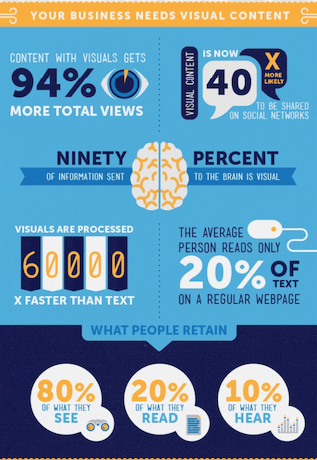Many business leaders make the mistake of relying solely on advertising and/ or direct sales to secure leads. These tried-and-true methods certainly have their place, but if they’re your company’s only form of customer outreach, then you could be leaving a lot on the table.
Today there are new channels and media to not only distribute your message, but engage and interact with potential customers, all while building relationships and establishing your brand. And while it’s a bit more work up front, content marketing comes at a fraction of the traditional cost for running ads or hiring additional salespeople.
Defining content marketing
What is content marketing? Well, it’s a form of marketing in which you create, publish and distribute content to attract, engage, and retain customers. Content is everything from blog posts to white papers and eBooks to videos—basically anything that helps people learn about your company.
The term “content” has become so overused that sometimes it seems like every company is doing some kind of “content marketing.” But the truth is that there are only a few types of companies who can actually benefit from this strategy. First off, if your customers don’t already know who you are or why they should use your product or service (which will be addressed later), then chances are good that they won’t care about what kind of content you’re creating for them. You must have some brand visibility before even considering investing in content creation and distribution. So if no one knows who you are yet…it might be better left alone until later when things change for the better (and hopefully sooner). If this is the case, some traditional PR might be the more logical first step.
What are the goals of content marketing?
In addition to the obvious ones—to build your brand and generate leads, grow your business and increase sales—you might be surprised to learn how content marketing can help you differentiate yourself from competitors.
It’s a fact that people trust recommendations much more than advertising. So if you want to stand out from other brands, consider creating helpful or entertaining content that gets shared by fans on social media. This way, customers can see that other people are getting value out of what you’re selling (and hopefully share it with their friends).
How to develop a content marketing strategy
To develop a content marketing strategy, you must first understand your buyer’s journey. This is the process that leads people who have never heard of you to become customers for life. Buyers’ journeys can be broken down into three main steps:
- Awareness (What do they know about me?)
- Consideration (Are they interested in using my services or products?)
- Conversion/Purchase
Content marketing tactics
When executing a content marketing strategy, businesses often rely on a mix of written, graphical and video media to disseminate their messaging. These typically include:
- Blog posts
- E-newsletters
- Videos
- Infographics
- Social media posts
Measurement and evaluation
It’s not enough to just create great content. You have to track how it performs, and use that data to improve your strategy as you go along.
Measurement is key to success with content marketing, but what exactly do you measure?
The answer depends on your goals and objectives, but some basic metrics are useful for tracking the performance of all types of content:
- Traffic: How much attention did your latest blog post or video get? How many visitors came from social media channels? This is a good place to start if you’re looking at overall performance of a piece of content—it’ll give you an idea of whether people are clicking through and reading/watching what they’re supposed to be reading/watching. Short-term traffic spikes can also be useful indicators that something went viral within the target audience (or outside it).
- Conversions: Did any readers take action after consuming your latest blog post or video? If so, did they visit another page on your website after reading/watching it—and how many times did they return over the next few weeks or months? This metric is closely tied into SEM (search engine marketing) strategies like AdWords advertising campaigns because it shows how successful paid ads were at driving traffic toward certain pages on your site. You might also see conversions if someone filled out a form asking for more information about services offered by your company; this could lead directly into further engagement down the road (e-mail newsletters and other forms of direct marketing).
Resources for content marketers
Content marketing is a skill that can be learned and refined, but it helps to have some guidance along the way. Here are some useful resources for content marketers:
- [The Content Strategist](http://thecontentstrategist.com/)
- [Copyblogger](https://www.copyblogger.com/) – blog by Brian Clark, founder of Copyblogger Media
- [Contently](https://contently.com/) – choose this if you’re looking for an agency/service provider
Developing your own content marketing strategy
You’re probably wondering: “What are some of the most important things I can do to develop a content marketing strategy and execute on it?”
Well, let us tell you. Content marketing is a way for companies to build trust with customers, generate leads and establish themselves as an authority in their industry. It is not just writing blog posts or creating videos. It’s not just creating infographics or social media posts either!
It’s all of these things and more—a comprehensive strategy that encompasses any type of digital asset that builds relevance between your business and its target audience over time through consistent delivery of valuable information (e.g., case studies).
Conclusion
Content marketing is a powerful tool, and we hope you’re well on your way to mastering it. It can be difficult to get started with content marketing, but if you follow the steps above and use the resources we provided, you’ll be off to a great start. And if you need a hand, don’t be afraid to reach out!






